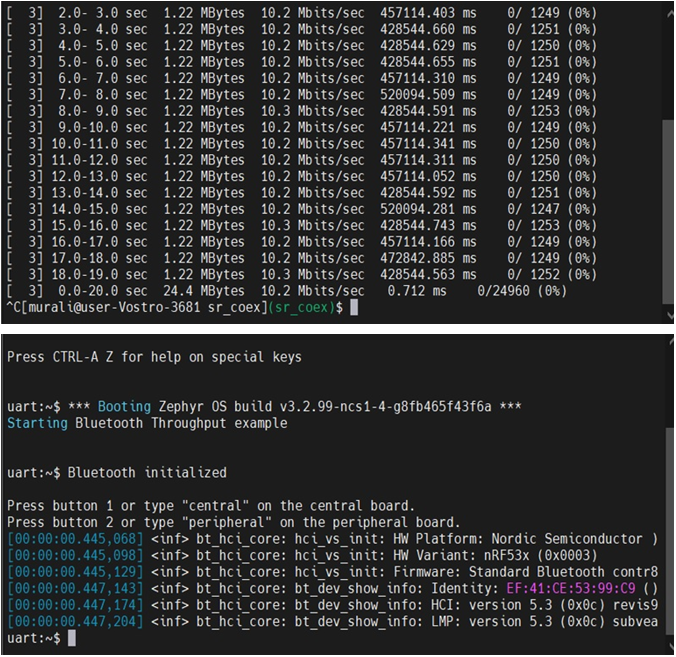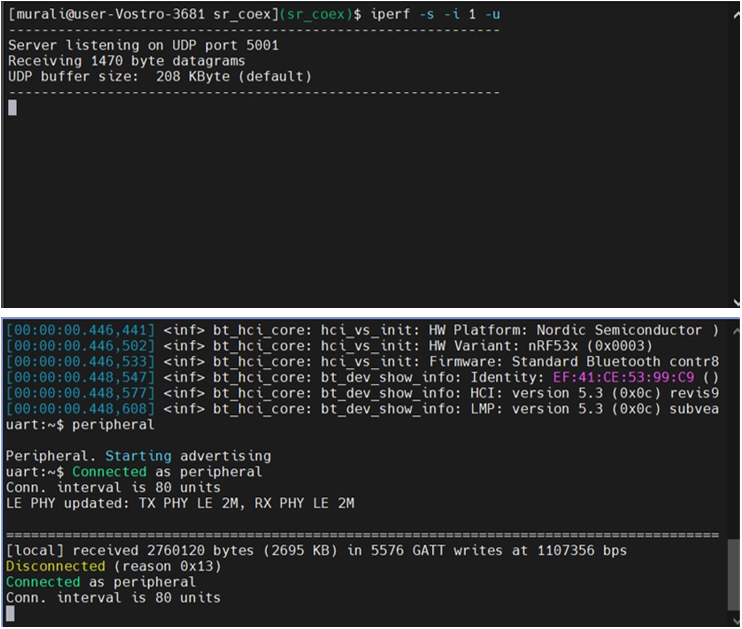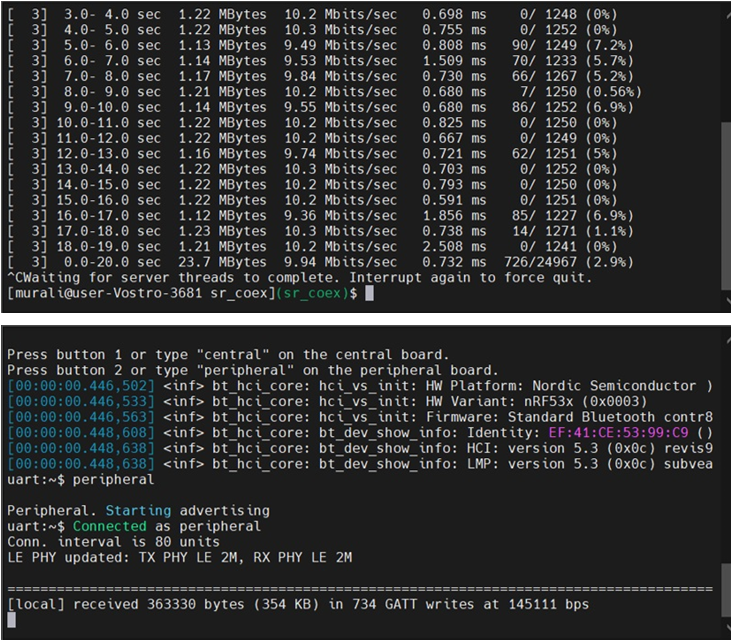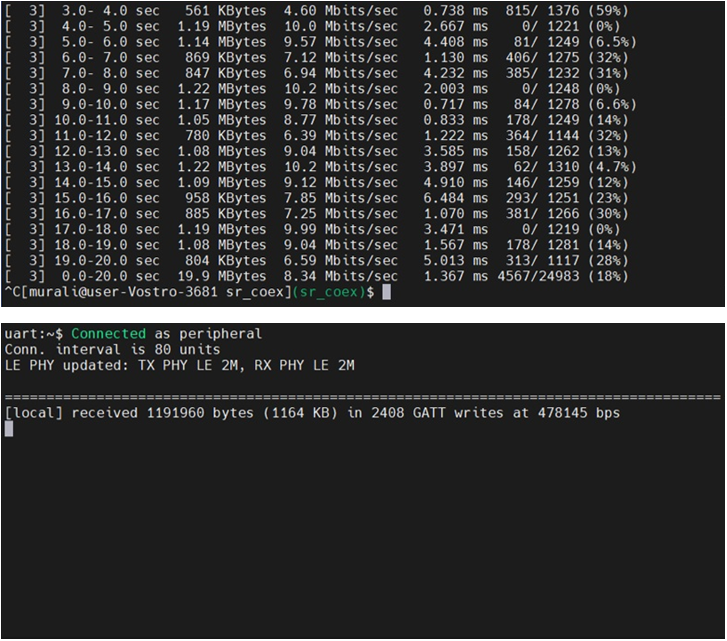Wi-Fi: Bluetooth LE coexistence
The Bluetooth LE coexistence sample demonstrates coexistence between Wi-Fi® and Short Range (SR) radios in 2.4 GHz frequency. The sample documentation includes details of test setup used, build procedure, test procedure and the results obtained when the sample is run on the nRF7002 DK.
Requirements
The sample supports the following development kit:
Hardware platforms |
PCA |
Board name |
Build target |
Shields |
|---|---|---|---|---|
PCA20053 |
|
|
||
PCA10143 |
|
|||
PCA10143 |
|
|||
PCA10095 |
|
|
Overview
The sample demonstrates how the coexistence mechanism is implemented and enabled and disabled between Wi-Fi and Bluetooth® LE radios in 2.4 GHz band using Wi-Fi client’s throughput and Bluetooth LE central’s throughput.
Test setup
The following figure shows a reference test setup.
Wi-Fi coexistence reference test and evaluation setup
The reference test setup shows the connections between the following devices:
Device Under Test (DUT) (nRF7002 DK on which the coexistence sample runs)
Wi-Fi peer device (access point with test PC that runs iperf)
Bluetooth LE peer device (nRF5340 DK on which Bluetooth LE throughput sample runs)
This setup is kept in a shielded test enclosure box (for example, a Ramsey box). The following table provides more details on the sample or application that runs on DUT and peer devices:
Device |
Application |
Details |
|---|---|---|
nRF7002 DK |
Bluetooth LE coex sample |
The sample runs Wi-Fi throughputs, Bluetooth LE throughputs
or a combination of both based on configuration selections in the
|
Test PC |
iperf application |
Wi-Fi iperf UDP server is run on the test PC, and this acts as a peer device to Wi-Fi UDP client that runs on the nRF7002 DK. |
nRF5340 DK |
Bluetooth LE throughput sample |
Bluetooth LE throughput sample is run in peripheral mode on the nRF5340 DK, and this acts as a peer device to Bluetooth LE central that runs on the nRF7002 DK. |
To trigger concurrent transmissions at RF level on both Wi-Fi and Bluetooth LE, the sample runs traffic on separate threads, one for each. The sample uses standard Zephyr threads. The threads are configured with non-negative priority (pre-emptible thread). For details on threads and scheduling, refer to Threads.
Configuration
See Configuring your application for information about how to permanently or temporarily change the configuration.
Configuration options
The following sample-specific Kconfig options are used in this sample (located in samples/wifi/sr_coex/Kconfig):
- CONFIG_COEX_SEP_ANTENNAS
This option specifies whether the antennas are shared or separate for Bluetooth and WLAN.
- CONFIG_TEST_TYPE_WLAN_ONLY
This option enables the WLAN test type.
- CONFIG_TEST_TYPE_BLE_ONLY
This option enables the Bluetooth LE test type.
- CONFIG_TEST_TYPE_WLAN_BLE
This option enables concurrent WLAN and Bluetooth LE tests.
- CONFIG_WIFI_TEST_DURATION
This option sets the Wi-Fi test duration in milliseconds.
- CONFIG_BLE_TEST_DURATION
This option sets the Bluetooth test duration in milliseconds.
- CONFIG_INTERVAL_MIN
This option sets the Bluetooth minimum connection interval (each unit is 1.25 milliseconds).
- CONFIG_INTERVAL_MAX
This option sets the Bluetooth maximum connection interval (each unit is 1.25 milliseconds).
- CONFIG_STA_SAMPLE_SSID
This option specifies the SSID to connect.
- CONFIG_STA_SAMPLE_PASSWORD
This option specifies the passphrase (WPA2) or password WPA3 to connect.
- CONFIG_STA_KEY_MGMT_*
These options specify the key security option.
- CONFIG_BT_THROUGHPUT_FILE
This option selects the type of the throughput test.
- CONFIG_BT_THROUGHPUT_DURATION
This option sets the Bluetooth throughput test duration in milliseconds.
Configuration files
To enable different test modes, set up the following configuration parameters in the prj.conf file:
Antenna configuration: Use the CONFIG_COEX_SEP_ANTENNAS Kconfig option to select the antenna configuration. Set it to
yto enable separate antennas andnto enable shared antenna.Test modes: Use the following Kconfig options to select the required test case:
CONFIG_TEST_TYPE_WLAN_ONLY for Wi-Fi only test
CONFIG_TEST_TYPE_BLE_ONLY for Bluetooth LE only test
CONFIG_TEST_TYPE_WLAN_BLE for concurrent Wi-Fi and Bluetooth LE test.
Based on the required test, set only one of these to
y.Test duration: Use the CONFIG_WIFI_TEST_DURATION Kconfig option to set the duration of the Wi-Fi test and CONFIG_BLE_TEST_DURATION for the Bluetooth LE test. The units are in milliseconds. For example, to set the tests for 20 seconds, set the respective values to
20000. For the concurrent Wi-Fi and Bluetooth LE test, make sure that both are set to the same duration to ensure maximum overlap.Bluetooth LE configuration: Set the Bluetooth LE connection interval limits using the CONFIG_INTERVAL_MIN and CONFIG_INTERVAL_MAX Kconfig options. The units are 1.25 milliseconds. For example,
CONFIG_INTERVAL_MIN=80corresponds to an interval of 100 ms (80 x 1.25).Wi-Fi connection: Set the following options appropriately as per the credentials of the access point used for this testing:
Note
menuconfig can also be used to enable the Key management option.
See Interactive Kconfig interfaces in the Zephyr documentation for instructions on how to run menuconfig.
Set up the following configuration parameters in the prj_nrf5340dk_nrf5340_cpuapp.conf file:
File or time-based throughput: Use CONFIG_BT_THROUGHPUT_FILE to select file or time-based throughput test. Set it to
nto enable time-based throughput test only when running Bluetooth LE throughput in central role.Test duration: Use CONFIG_BT_THROUGHPUT_DURATION to set the duration of the Bluetooth LE throughput test only when running Bluetooth LE throughput in central role. The units are in milliseconds.
Note
Use the same test duration value for CONFIG_WIFI_TEST_DURATION, CONFIG_BLE_TEST_DURATION, and CONFIG_BT_THROUGHPUT_DURATION.
Building and running
This sample can be found under samples/wifi/sr_coex in the nRF Connect SDK folder structure.
When built as firmware image for the _ns build target, the sample has Cortex-M Security Extensions (CMSE) enabled and separates the firmware between Non-Secure Processing Environment (NSPE) and Secure Processing Environment (SPE).
Because of this, it automatically includes the Trusted Firmware-M (TF-M).
To read more about CMSE, see Processing environments.
To build the sample with Visual Studio Code, follow the steps listed on the How to build an application page in the nRF Connect for VS Code extension documentation. See Building and programming an application for other building and programming scenarios and Testing and debugging an application for general information about testing and debugging in the nRF Connect SDK.
The sample can be built for the following configurations:
Wi-Fi throughput only
Bluetooth LE throughput only
Concurrent Wi-Fi and Bluetooth LE throughput (with coexistence enabled and disabled mode)
To build for the nRF7002 DK, use the nrf7002dk_nrf5340_cpuapp build target.
The following are examples of the CLI commands:
Build with coexistence disabled:
west build -p -b nrf7002dk_nrf5340_cpuapp -- -DCONFIG_MPSL_CX=n -Dhci_rpmsg_CONFIG_MPSL_CX=n
Use this command for Wi-Fi throughput only, Bluetooth LE throughput only, or concurrent Wi-Fi and Bluetooth LE throughput with coexistence disabled tests.
Build with coexistence enabled:
west build -p -b nrf7002dk_nrf5340_cpuapp -- -DCONFIG_MPSL_CX=y -Dhci_rpmsg_CONFIG_MPSL_CX=y
Use this command for concurrent Wi-Fi and Bluetooth LE throughput with coexistence enabled test.
Change the build target as given below for the nRF7001 DK, nRF7002 EK and nRF7001 EK.
Build target for nRF7001 DK:
nrf7002dk_nrf7001_nrf5340_cpuappBuild target for nRF7002 EK and nRF7001 EK:
nrf5340dk_nrf5340_cpuapp
Add the following SHIELD options for the nRF7002 EK and nRF7001 EK.
For nRF7002 EK:
-DSHIELD=nrf7002ek -Dhci_rpmsg_SHIELD=nrf7002ek_coexFor nRF7001 EK:
-DSHIELD=nrf7002ek_nrf7001 -Dhci_rpmsg_SHIELD=nrf7002ek_nrf7001_coex
The generated HEX file to be used is sr_coex/build/zephyr/merged_domains.hex.
Use the Bluetooth throughput sample from the nrf/samples/bluetooth/throughput folder on the peer nRF5340 DK device.
Build for the nRF5340 DK:
west build -p -b nrf5340dk_nrf5340_cpuapp
The generated HEX file to be used is throughput/build/zephyr/merged_domains.hex.
Connecting to DKs
After the DKs are connected to the test PC through USB connectors and powered on, open a suitable terminal, and run the following command:
$ nrfjprog --com
1050043161 /dev/ttyACM0 VCOM0
1050043161 /dev/ttyACM1 VCOM1
1050724225 /dev/ttyACM2 VCOM0
1050724225 /dev/ttyACM3 VCOM1
$
In this example, 1050043161 is the device ID of the nRF5340 DK and 1050724225 is device ID of the nRF7002 DK.
While connecting to a particular board, use the ttyACMx corresponding to VCOM1.
In the example, use ttyACM1 to connect to the board with device ID 1050043161.
Similarly, use ttyACM3 to connect to the board with device ID 1050724225.
$ minicom -D /dev/ttyACM1 -b 115200
$ minicom -D /dev/ttyACM3 -b 115200
Programming DKs
To program the nRF5340 DK:
Open a new terminal in the test PC.
Navigate to
<ncs code>/nrf/samples/bluetooth/throughput/.Run the following command:
$ west flash --dev-id <device-id> --hex-file build/zephyr/merged_domains.hex
To program the nRF7002 DK:
Open a new terminal in the test PC.
Navigate to
<ncs code>/nrf/samples/wifi/sr_coex/.Run the following command:
$ west flash --dev-id <device-id> --hex-file build/zephyr/merged_domains.hex
Testing
Running coexistence sample test cases require additional software such as the Wi-Fi iperf application. When the sample runs Wi-Fi UDP throughput in client mode, a peer device runs UDP throughput in server mode using the following command:
$ iperf -s -i 1 -u
Use iperf version 2.0.5. For more details, see Network Traffic Generator.
Test case |
Coexistence |
Test procedure |
|---|---|---|
Wi-Fi only throughput |
NA |
Run Wi-Fi iperf in server mode on the test PC. Program the coexistence sample application on the nRF7002 DK. |
Bluetooth LE only throughput |
NA |
Program Bluetooth LE throughput application on the nRF5340 DK and select role as peripheral. Program the coexistence sample application on the nRF7002 DK. |
Wi-Fi and Bluetooth LE combined throughput |
Disabled/ Enabled |
Run Wi-Fi iperf in server mode on the test PC. Program Bluetooth LE throughput application on the nRF5340 DK and select role as peripheral. Program the coexistence sample application on the nRF7002 DK. |
The Wi-Fi throughput result appears on the test PC terminal on which iperf server is run. The Bluetooth LE throughput result appears on the minicom terminal connected to the nRF5340 DK.
Results
The following tables collect a summary of results obtained when coexistence tests are run for different Wi-Fi operating bands, antenna configurations, and Wi-Fi modes. The tests are run with the test setup inside an RF shield box. Therefore, the results are representative and might change with adjustments in the test setup.
Wi-Fi in 2.4 GHz
Separate antennas, Wi-Fi in 802.11n mode:
Test case |
Wi-Fi UDP Tx throughput in Mbps |
Bluetooth LE throughput in kbps |
|---|---|---|
Wi-Fi only, client (UDP Tx) |
10.2 |
N.A |
Bluetooth LE only, central |
N.A |
1107 |
Wi-Fi and Bluetooth LE, coexistence disabled |
9.9 |
145 |
Wi-Fi and Bluetooth LE, coexistence enabled |
8.3 |
478 |
Shared antenna, Wi-Fi in 802.11n mode:
Test case |
Wi-Fi UDP Tx throughput in Mbps |
Bluetooth LE throughput in kbps |
|---|---|---|
Wi-Fi only, client (UDP Tx) |
10.2 |
N.A |
Bluetooth LE only, central |
N.A |
1219 |
Wi-Fi and Bluetooth LE, coexistence disabled |
10.2 |
29 |
Wi-Fi and Bluetooth LE, coexistence enabled |
6.2 |
749 |
Separate antennas, Wi-Fi in 802.11b mode:
Test case |
Wi-Fi UDP Tx throughput in Mbps |
Bluetooth LE throughput in kbps |
|---|---|---|
Wi-Fi only, client (UDP Tx) |
3.5 |
N.A |
Bluetooth LE only, central |
N.A |
1042 |
Wi-Fi and Bluetooth LE, coexistence disabled |
3.3 |
110 |
Wi-Fi and Bluetooth LE, coexistence enabled |
2.2 |
563 |
Shared antenna, Wi-Fi in 802.11b mode:
Test case |
Wi-Fi UDP Tx throughput in Mbps |
Bluetooth LE throughput in kbps |
|---|---|---|
Wi-Fi only, client (UDP Tx) |
3.5 |
N.A |
Bluetooth LE only, central |
N.A |
1190 |
Wi-Fi and Bluetooth LE, coexistence disabled |
3.4 |
59 |
Wi-Fi and Bluetooth LE, coexistence enabled |
2.2 |
508 |
Wi-Fi in 5 GHz
Separate antennas, Wi-Fi in 802.11n mode:
Test case |
Wi-Fi UDP Tx throughput in Mbps |
Bluetooth LE throughput in kbps |
|---|---|---|
Wi-Fi only, client (UDP Tx) |
10.2 |
N.A |
Bluetooth LE only, central |
N.A |
1139 |
Wi-Fi and Bluetooth LE, coexistence disabled |
10.2 |
1188 |
Wi-Fi and Bluetooth LE, coexistence enabled |
10.2 |
1208 |
Shared antenna, Wi-Fi in 802.11n mode:
Test case |
Wi-Fi UDP Tx throughput in Mbps |
Bluetooth LE throughput in kbps |
|---|---|---|
Wi-Fi only, client (UDP Tx) |
10.2 |
N.A |
Bluetooth LE only, central |
N.A |
1180 |
Wi-Fi and Bluetooth LE, coexistence disabled |
10.2 |
1177 |
Wi-Fi and Bluetooth LE, coexistence enabled |
10.2 |
1191 |
Sample output
The following screenshots show coexistence test results obtained for separate antenna configuration with Wi-Fi mode set to 802.11n. These tests were run with WLAN connected to an AP in 2.4 GHz band. In the images, the top image result shows Wi-Fi throughput that appears on a test PC terminal in which Wi-Fi iperf server is run and the bottom image result shows Bluetooth LE throughput that appears on a minicom terminal in which the Bluetooth LE throughput sample is run.

Wi-Fi only throughput 10.2 Mbps

Bluetooth LE only throughput: 1107 kbps

Wi-Fi and Bluetooth LE throughput, coexistence disabled: Wi-Fi 9.9 Mbps and Bluetooth LE 145 kbps

Wi-Fi and Bluetooth LE throughput, coexistence enabled: Wi-Fi 8.3 Mbps and Bluetooth LE 478 kbps
As is evident from the results of the sample execution, coexistence harmonizes air-time between Wi-Fi and Bluetooth LE rather than resulting in a higher combined throughput. This is consistent with the design intent.
Dependencies
This sample uses the following library:
